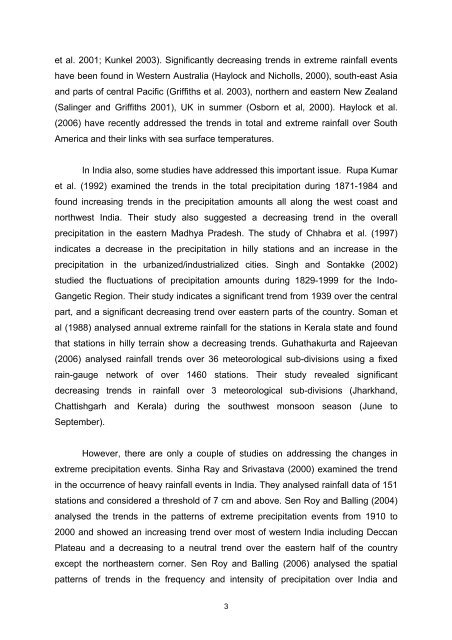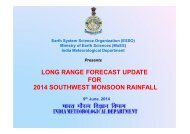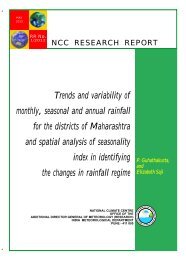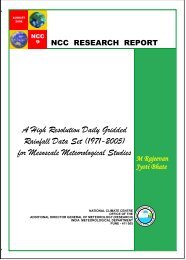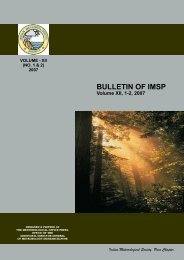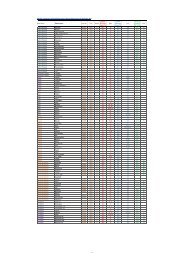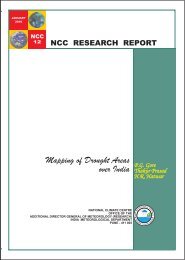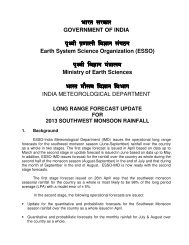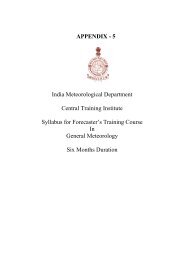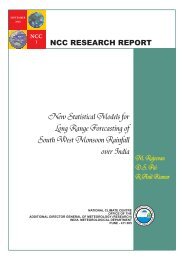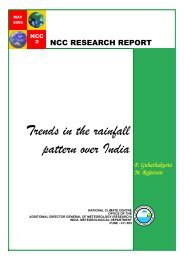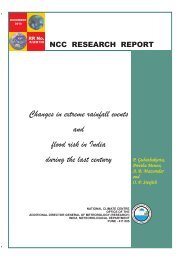Trends in Precipitation Extremes over India - (IMD), Pune
Trends in Precipitation Extremes over India - (IMD), Pune
Trends in Precipitation Extremes over India - (IMD), Pune
You also want an ePaper? Increase the reach of your titles
YUMPU automatically turns print PDFs into web optimized ePapers that Google loves.
et al. 2001; Kunkel 2003). Significantly decreas<strong>in</strong>g trends <strong>in</strong> extreme ra<strong>in</strong>fall eventshave been found <strong>in</strong> Western Australia (Haylock and Nicholls, 2000), south-east Asiaand parts of central Pacific (Griffiths et al. 2003), northern and eastern New Zealand(Sal<strong>in</strong>ger and Griffiths 2001), UK <strong>in</strong> summer (Osborn et al, 2000). Haylock et al.(2006) have recently addressed the trends <strong>in</strong> total and extreme ra<strong>in</strong>fall <strong>over</strong> SouthAmerica and their l<strong>in</strong>ks with sea surface temperatures.In <strong>India</strong> also, some studies have addressed this important issue. Rupa Kumaret al. (1992) exam<strong>in</strong>ed the trends <strong>in</strong> the total precipitation dur<strong>in</strong>g 1871-1984 andfound <strong>in</strong>creas<strong>in</strong>g trends <strong>in</strong> the precipitation amounts all along the west coast andnorthwest <strong>India</strong>. Their study also suggested a decreas<strong>in</strong>g trend <strong>in</strong> the <strong>over</strong>allprecipitation <strong>in</strong> the eastern Madhya Pradesh. The study of Chhabra et al. (1997)<strong>in</strong>dicates a decrease <strong>in</strong> the precipitation <strong>in</strong> hilly stations and an <strong>in</strong>crease <strong>in</strong> theprecipitation <strong>in</strong> the urbanized/<strong>in</strong>dustrialized cities. S<strong>in</strong>gh and Sontakke (2002)studied the fluctuations of precipitation amounts dur<strong>in</strong>g 1829-1999 for the Indo-Gangetic Region. Their study <strong>in</strong>dicates a significant trend from 1939 <strong>over</strong> the centralpart, and a significant decreas<strong>in</strong>g trend <strong>over</strong> eastern parts of the country. Soman etal (1988) analysed annual extreme ra<strong>in</strong>fall for the stations <strong>in</strong> Kerala state and foundthat stations <strong>in</strong> hilly terra<strong>in</strong> show a decreas<strong>in</strong>g trends. Guhathakurta and Rajeevan(2006) analysed ra<strong>in</strong>fall trends <strong>over</strong> 36 meteorological sub-divisions us<strong>in</strong>g a fixedra<strong>in</strong>-gauge network of <strong>over</strong> 1460 stations. Their study revealed significantdecreas<strong>in</strong>g trends <strong>in</strong> ra<strong>in</strong>fall <strong>over</strong> 3 meteorological sub-divisions (Jharkhand,Chattishgarh and Kerala) dur<strong>in</strong>g the southwest monsoon season (June toSeptember).However, there are only a couple of studies on address<strong>in</strong>g the changes <strong>in</strong>extreme precipitation events. S<strong>in</strong>ha Ray and Srivastava (2000) exam<strong>in</strong>ed the trend<strong>in</strong> the occurrence of heavy ra<strong>in</strong>fall events <strong>in</strong> <strong>India</strong>. They analysed ra<strong>in</strong>fall data of 151stations and considered a threshold of 7 cm and above. Sen Roy and Ball<strong>in</strong>g (2004)analysed the trends <strong>in</strong> the patterns of extreme precipitation events from 1910 to2000 and showed an <strong>in</strong>creas<strong>in</strong>g trend <strong>over</strong> most of western <strong>India</strong> <strong>in</strong>clud<strong>in</strong>g DeccanPlateau and a decreas<strong>in</strong>g to a neutral trend <strong>over</strong> the eastern half of the countryexcept the northeastern corner. Sen Roy and Ball<strong>in</strong>g (2006) analysed the spatialpatterns of trends <strong>in</strong> the frequency and <strong>in</strong>tensity of precipitation <strong>over</strong> <strong>India</strong> and3


